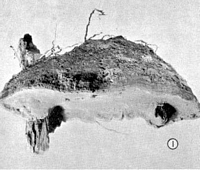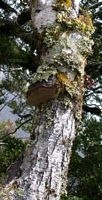|
 Phellinus wahlbergii Phellinus wahlbergii
SynonymsPhellinus pomaceus
Phellinus setulosus
Poria uncinata
Fomes senex var. hamatus
Fomes uncatus
Polyporus victoriae
Fomes hamatus
Fomes pomaceus
Fomes zealandicus
Fuscoporia uncinata
Phellinus laurencii
Phellinus senex var. hamatus
Phellinus zealandicus
Scindalma zealandicum
Polyporus laurencii
Trametes wahlbergii
Poria victoriae
Polyporus rubiginosus
Polyporus zealandicus
Fuscoporia wahlbergii
BiostatusPresent in region - Indigenous. Non endemic
Images (click to enlarge)
Caption: Fig. 1. Fomes uncatus, x 1/2. Showing ungulate shape and finely zoned surface. | 
Caption: Phellinus wahlbergii
Owner: Nils Hallenberg |
Article: Buchanan, P.K.; Ryvarden, L. (1988). Type studies in the Polyporaceae - 18. Species described by G.H. Cunningham. Mycotaxon 31(1): 1-38.
Notes: Phellinus wahlbergii is characterised by hooked setae and subglobose, hyaline spores, 4-5.5 x 3.5-5
µm. Cunningham (1965: 222) mistakenly included F. uncatus as a synonym of Phellinus setulosus
(Lloyd) Imaz. but the latter is tropical, typically ungulate, and has large, ventricose, straight setae
and larger spores. Australasian specimens included by Cunningham under P. setulosus and P.
zealandicus (Cooke) G.H. Cunn. are considered to be conspecific with P. wahlbergii.
A single type collection for F. uncatus was not designated by Cunningham (1948b). Two
collections, PDD 5776 and PDD 5777 have the same data as given in the protologue for the type ,
except for the date, May 1947 vs June 1947. An error in citation of the date in the protologue is
suggested. PDD 5776 is herein designated the lectotype of F. uncatus; this specimen has a majority
of setae with hooked apices whereas setae in PDD 5777 are mostly straight.
Cunningham (1948b, 1965) described the rot caused by this fungus as brown but as with all species
of Phellinus the rot is white.
Article: Gadgil, P.D. (in association with Dick, M.A.; Hood, I.A.; Pennycook, S.R.) (2005). Fungi on trees and shrubs in New Zealand. Fungi of New Zealand. Ngā Harore o Aotearoa 4: xi + 437 p. Hong Kong: Fungal Diversity Press.
Description: Type: Lignicolous Fungi; Description: Basidiomata perennial, solitary or with overlapping pilei, leathery to woody, attached by a broad lateral base. Pilei applanate, occasionally effused-reflexed, 50–250 mm wide, 5–20 mm thick. Pileus surface tomentose, narrowly banded in sulcate to flat zones, reddish brown to umber. Pore surface even, deep rusty brown to chestnut brown; pores small, 7–8 per mm. Context chestnut brown, up to 5 mm thick. Hyphal system dimitic. Setae hooked or less commonly straight, or both hooked and straight in the same fruiting body, acuminate, 15–30 × 6–9 μm, dark brown. Basidiospores subglobose, 4–5 × 3–4 μm, smooth, hyaline to pale yellow.
Distribution: Distribution: Northland, Auckland, Coromandel, Waikato, Bay of Plenty, Taranaki, Taupo, Wellington, Westland, Southland, Stewart Island.; 1st Record: Cunningham (1948d: as Fomes hamatus — see Cunningham 1949); Buchanan & Ryvarden (2000).
Article: Cunningham, G.H. (1948). New Zealand Polyporaceae. 8. The genus Fomes. New Zealand Department of Scientific and Industrial Research, Plant Diseases Division, Bulletin 79: 24 p.
Description: Hymenophore perennial, solitary, dimidiate, firm and woody. Pileus ungulate, to 23 cm. x 12
cm. x 8 cm.; surface concentrically sulcate and ridged, at first fawn or ferruginous, becoming
umber or black near the base, cuticle to 0.5 mm. thick, black, hard, brittle, of woven hyphae
cemented into a layer which tends to crack and flake away save peripherally; margin obtuse,
even, tomentose; hymenial surface plane or slightly convex, ferruginous, sterile border 1-3
mm. wide, tomentose, fulvous, dissepiments not toothed. Context 1-5 mm. thick, chestnut-brown or fulvous, hyphae mostly radiately arranged; skeletal hyphae 3-3.5 µ thick, lumen 1 µ,
chestnut-brown, sparsely branched, aseptate; generative hyphae 2-2.5 µ thick, delicate walled,
branched, septate, hyaline. Pores round, obscurely stratose, each layer 2-5 mm. deep,
ferruginous in section, 100-150 µ diameter, or 5-7 per mm.; dissepiments 75-150 µ thick,
equal, apex finely velutinate. Sets mostly uncinate, a few subulate. chestnut-brown, 16-36 x
6-8 µ, wall to 2 µ. Basidia clavate, 8-12 x 4-6 µ. Spores globose, subglobose, or broadly
obovate, 3.5-5 x :3.5-4 µ, smooth, hyaline.
Habitat: HABITAT : Growing solitary upon bark of standing dead trees, associated with a brown
pocket-rot.
Distribution: DISTRIBUTION : New Zealand.
Notes: Separated from F. hamatus, which the species resembles in several features, including
hooked setae, by the ungulate pileus and presence of a definite cuticle. Most setae are hooked,
with apices turned towards the hymenium, or at least at right-angles; a few are subulate.
Article: Dingley, J.M. (1969). Records of plant diseases in New Zealand. New Zealand Department of Scientific and Industrial Research, Bulletin 192: 298 p. Wellington:.
Notes: This fungus was described from New Zealand by Cooke in 1879 from Coromandel,
New Zealand; Cunningham (1948f) listed it as occurring on five hosts but confused the
species with F. senex. Gilmour (1966a) states that it is a common white heart rot on
some endemic forest trees.
Article: Cooke, M.C. (1879). New Zealand fungi. Grevillea 8(46): 54-68.
Notes: No. 309 is evidently a resupinate form of No. 310. Three to six inches broad, when resupinate
extending for nearly a foot. The hymenium is surrounded by a broad sterile, velvety margin,
which is scarcely so distinct in the resupinate form. Allied to P. applanatus, Fr., but, quite
distinct.
|